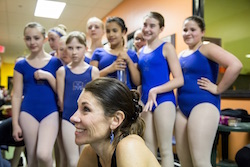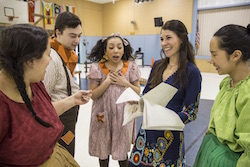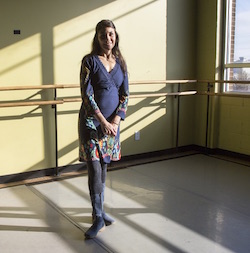Deluxe Corporation, a growth engine for small businesses and financial institutions, is running a year-long, national campaign to promote small businesses through photo essays and documentaries. The campaign, known as Small Business Revolution, chose Adalhi Aranda as one of 100 entrepreneurs and businesses to highlight.
Aranda is the founder and director of Bluegrass Youth Ballet, a non-profit dance school in Lexington, Kentucky that emphasizes healthy minds as well as healthy bodies through quality dance education. What stood out to Small Business Revolution was Aranda’s supportive and uplifting methods of teaching ballet to young students – methods that might seem quite revolutionary compared to ballet’s often old school regime of discipline and tough love.

Class at the Bluegrass Youth Ballet school in Lexington, Kentucky. Photo by Deluxe Corporation.
“Adali has really taken an approach to dance instruction that focuses on empowering young dancers, really building their self-esteem,” says Amanda Brinkmam, a representative of Deluxe Corp. “We loved that she is trying to teach ballet with a focus and that she is also very involved with the local community.”
This community focus is perhaps what makes Bluegrass Youth Ballet so unique, and also so successful, in the Lexington area. BYB doesn’t just put on ‘typical recitals’ with their students, but instead promotes culture through high quality performances, often in the form of original story ballets, in a family-friendly, community atmosphere.
As a young dance student in Mexico, Aranda was discouraged by the negative, hard-edged approach her dance training promoted, and she saw many of her peers quit dancing as a result.
“I had a really hard time growing up with people who didn’t believe in you,” Aranda says. “They made it impossible and played mind games, and I wanted it to be something different than that.”
Despite these struggles Aranda continued to dance professionally, first in Mexico and then for several companies in the United States. She landed in Kentucky, ready to transition from performing to teaching, and felt that the most natural step was to start her own school. Alongside a commitment to quality dance education, Aranda also promotes cultural understanding at BYB by sharing her Hispanic heritage through her ballets, which often integrate Mexican stories and folk tales throughout the plot lines.

Adalhi Aranda director and founder of the Bluegrass Youth Ballet school, here directs a play, ‘Senora Tortuga,’ at the Maxwell Elementary school in Lexington, Kentucky. Photo by Deluxe Corporation.
This dedication to sharing and appreciation is rooted in her students’ daily experience in the dance studio. While still loyal to teaching strong technique and challenging her students, Aranda says that her school is “a kind of haven for the kids,” a place where children can focus on dancing without worrying about gossip and negativity.
“[My students] grow together. They treat each other like sisters,” she says. “ I teach strong, hard classes, but I always approach the kids with a smile, you know, try to inspire them by making them feel special and that they are lucky by the fact that they are dancers and that we get to do this.”
In terms of financial realities, these students are in fact very lucky to have place like BYB, which offers work-study opportunities to students in financial difficulty, where they can dance. Using the big fish vs. small pond analogy, Aranda acknowledges while local support is enthusiastic, BYB does not get much recognition nationally. Despite sending their students on to compete in competitions such as the Grand Prix and to dance professionally in ballet companies, Aranda says that they “are small compared to other places.”
This why, when Small Business Revolution reached to Aranda about documenting her work, she was thrilled.
“The experience has been amazing. We were really excited that more people would know about BYB around the country,” she says.

Director and Founder of the Bluegrass Youth Ballet, Adalhi Aranda. Photo by Deluxe Corporation.
Being featured by Small Business Revolutions is an opportunity for more publicity in local markets, and sometimes nationally, according to Brinkman. She explains further:
“What we’re really trying to do is create a movement with all of this. We want more people to support small businesses and to recognize the great role they play in their communities. And we feel like by telling more of these stories and through more media outlets which are self-telling these stories, it just draws the attention to the fact that small businesses are the backbone of America. The more we can get those stories out there, the more people will be compelled to support.”
Aranda understands that how she trains and encourages her students eventually comes back to her organization via audience support. While she wants all of her students to succeed at dancing professionally if that is their dream, she also acknowledges the benefits of quality dance education in students who choose a different professional path.
“There are these people who have trained all these years through high school,” she says, “and then that’s it, that’s the end, and even though it’s hard to see a performer stop at such young age, I ask them just to look at all the things I have given to them and all the enrichment that their lives have because of ballet. And these people will become supporters and will become amazing audience members because they know when they are watching something good and something not so good. They are great critics.”
For more information about Bluegrass Youth Ballet visit www.bluegrassyouthballet.org.
By Katherine Moore of Dance Informa.
Photo (top): Class at the Bluegrass Youth Ballet school in Lexington, Kentucky. Photo by Deluxe Corporation.









